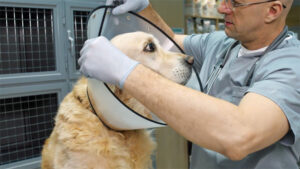rving with pets - paws on board
What to Do When Your Pet Breaks a Nail and What to Watch For
Welcome “RVing Today’s” “Paws on Board,” I’m Dr. Fitz, and this is Sully. Today, we’re gonna be discussing what you should do if your pet breaks a nail. Dogs and even cats can break their nails in a variety of ways. Some young or high-energy dogs and cats like to run around and often stop and turn quickly. We usually see this when they have the zoomies. Some dogs will get their nails stuck between boards on a deck or even on a dock if near water. Cats can also get their nails stuck on furniture or in carpeting. However they do it, broken nails can be a pain to deal with and usually should be taken care of as soon as possible.
When a pet breaks a nail, they usually do it in such a way that the “quick” is exposed. The “quick” is the collection of nerve fibers and blood vessels that feed the nail. When this is exposed, it can be very painful. As a comparison, think of how sensitive your nail beds are. If you get something stuck under your nail, this can hurt pretty badly. Once a nail is broken, it can bleed profusely depending on the extent of the damage, and some pets won’t let their owners touch the paw. Occasionally, the bleeding will stop on its own but can start up again if the clot is disturbed when the pet runs or walks. So what should you do if you think your pet has broken a nail?
 First, try to keep them confined to a small area such as a bathroom. This will keep the mess contained but also reduce the amount of contamination to the nail. Second, grab your handy first-aid kit and the necessary supplies. You’ll need a nonstick dressing, gauze padding and self-adherent wrap, and scissors. Third, if your pet will let you, gently apply the nonstick dressing and then the gauze padding to the nail, and then wrap lightly with the self-adherent dressing. This can help to stop any bleeding and will keep the nail bed protected. But, remember, a broken nail can be very painful, so if your pet is attempting to bite, do not wrap the paw, and take them right to a vet. If you’re able to wrap the paw, your pet should then be taken to a veterinarian for assessment. Sometimes there are remaining pieces of broken nail that should be removed, and your pet will often need pain medication and antibiotics for several days. Also, keep in mind that, if larger pieces of broken nail are still fairly attached, your pet may need some sedation to allow for safe and pain-free removal of the nail. Often, we send pets home with a temporary bandage on the foot and a cone to prevent them from licking and chewing at the nail. If you already have a cone for your pet, this could be helpful to bring along on your trip. If you’re not able to see a vet right away, you can keep the paw covered and keep a cone on your pet. If you have to wait until the next day, try to change the bandage at least once before then to prevent infection from a wet bandage.
First, try to keep them confined to a small area such as a bathroom. This will keep the mess contained but also reduce the amount of contamination to the nail. Second, grab your handy first-aid kit and the necessary supplies. You’ll need a nonstick dressing, gauze padding and self-adherent wrap, and scissors. Third, if your pet will let you, gently apply the nonstick dressing and then the gauze padding to the nail, and then wrap lightly with the self-adherent dressing. This can help to stop any bleeding and will keep the nail bed protected. But, remember, a broken nail can be very painful, so if your pet is attempting to bite, do not wrap the paw, and take them right to a vet. If you’re able to wrap the paw, your pet should then be taken to a veterinarian for assessment. Sometimes there are remaining pieces of broken nail that should be removed, and your pet will often need pain medication and antibiotics for several days. Also, keep in mind that, if larger pieces of broken nail are still fairly attached, your pet may need some sedation to allow for safe and pain-free removal of the nail. Often, we send pets home with a temporary bandage on the foot and a cone to prevent them from licking and chewing at the nail. If you already have a cone for your pet, this could be helpful to bring along on your trip. If you’re not able to see a vet right away, you can keep the paw covered and keep a cone on your pet. If you have to wait until the next day, try to change the bandage at least once before then to prevent infection from a wet bandage.
As a side note, we do not recommend bandaging your pet’s foot with duct tape or keeping a bandage on for more han 24 hours at a time. Duct tape can be very difficult and painful to remove and is often applied too tight. Bandages that are kept on for too long often cause more harm than good and can lead to serious pain and infection. Moral of the story, have a first-aid kit and having a first-aid kit and even a cone with you while traveling, and keep a list of local vets on hand so your pet could be cared for quickly. Be safe and be prepared when traveling with your pets.
Tune in next time for more pet-health information. I’m Dr. Fitz, and this is Sully. Thanks for watching “Paws on Board.”
Good job, buddy.

